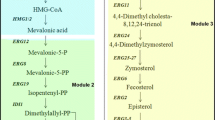Abstract
The Schizosaccharomyces pombe sck2 gene, originally identified as SPAC22E12.14c in the genome-sequencing project, encodes a putative protein kinase highly similar to Saccharomyces cerevisiae Sch9p and S. pombe Sck1p, both of which can suppress loss of cAMP-dependent protein kinase (PKA) if over-produced. Over-expression of sck2 suppressed typical phenotypes of PKA-defective cells, including ectopic mating, slow growth and short cell morphology. Wild-type cells over-expressing sck2 behaved like the PKA-hyperactive mutant. Disruption of sck2 caused no obvious phenotype, but it intensified de-repression for sexual development when combined with the disruption of sck1. The pka1 sck1 sck2 triple disruptant could grow but only very slowly. Whereas disruption of sck1 enhanced the inefficiency of Δpka1 spores in germination, disruption of sck2 did not. These results suggest that the molecular function of Sck2p largely overlaps with that of Sck1p, but also that they differ somewhat either quantitatively or qualitatively.
Similar content being viewed by others
Author information
Authors and Affiliations
Additional information
Received: 30 December 1997 / 20 January 1998
Rights and permissions
About this article
Cite this article
Fujita, M., Yamamoto, M. S. pombe sck2+, a second homologue of S. cerevisiae SCH9 in fission yeast, encodes a putative protein kinase closely related to PKA in function. Curr Genet 33, 248–254 (1998). https://doi.org/10.1007/s002940050333
Issue Date:
DOI: https://doi.org/10.1007/s002940050333




